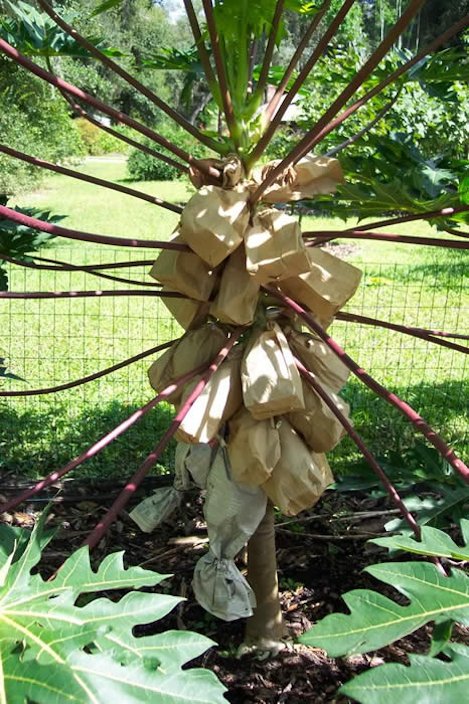Post on the Garden Web Forum
by Christine
How to Protect your Papaya Fruit from the Papaya Fruit Fly
"There are 3 types of papaya plants; male, female, and
self-fertile. After growing other unnamed papayas, I am quite satisfied
with the Red Lady. (I buy the seeds from ECHO, Ft. Myers.) Red Ladys
are dwarf. Notice how low to the ground the fruit set is. Also, because
they are dwarf they will set (good tasting) fruit sooner. The other
reason is because they are self-fertile. When I grew the male/female
types, I found that there was a high percentage of males in my
seedlings, so some years I didn't get any fruit."
"I can't say
that this is the best fruiting papaya for everyone in Central Florida,
but it works quite well for me. That little plant had at least 24
medium to large fruits on it. I have 3 other Red Ladys. They only have
about 8 or so fruits on them, but they ended up growing even larger."

"If
you look carefully at the photo of the Red Lady, the new small fruits
are not covered with paper bags. Those are knee-high nylon stockings
folded in half. The reason for using the knee-high stockings in the
very beginning is because the weight of the paper bag can snap off the
fruit. When the stem gets strong enough then I put on the bag. The
reason for folding the knee-high in half is because I witnessed a fruit
fly getting through a single layer."
"The paper bags and
newspapers are to prevent the fruit flies from laying their eggs inside
the papaya when they are young. It doesn't aid ripening that's why I
recently took the coverings off. Use newspapers when the fruits get too
big for the lunch bags."
"In my area papaya plants are grown as
an annual or annual that regenerates from being frozen back. I start my
seeds around Labor Day and then keep them potted until mid-March. I
plant them in my vegetable garden where the soil has been greatly
improved. I plant them in purchased mushroom compost and some potting
soil. I mulch them heavily with wood chips. They get watered from the
sprinkler system for the garden. They are heavy feeders so I will use
liquid fertilizers every few weeks. Of course, they like lots of sun.
For winter protection I mound up wood chips on the base of the plant
about 3 feet high. When all danger of a frost has past then I will
remove it and prune off the dead parts. Then I will let the plant keep
one or two branches."
Note: Christine lives in Central Florida. The cultivar 'Red Lady' grows well in South Florida too.
Back to
Papaya Page
Papaya Pests Page
|
|